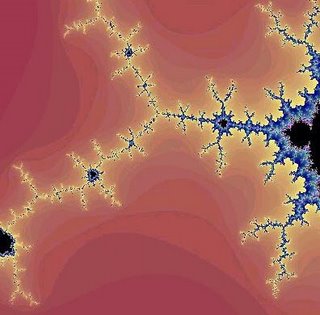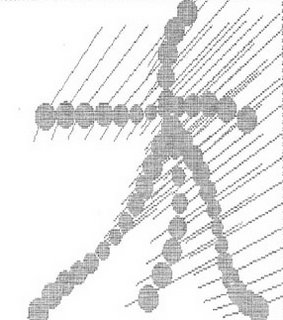wk05 Synestesia Project
0 Comments Published by Sam Leung on Wednesday, October 11, 2006 at 12:36 AM.
Biography

Lauri Gröhn: A
He started his industrial career in autumn 1976 in Kone Company in a group developing the first microcomputer controlled elevators. Then he worked in Telenokia (now called Nokia Telecommunications ) developing the first distributed digital switching systems. As a software QA manager he helped the company to survive without software crises by introducing the software configuration management methodologies.
Artist Statement
Using the method I have been developing one can generate music (midi files) from any pictures. Sculptural work is a good metaphor for the method: the sculptor starts from a block of stone or tree which inspires toward a certain end result. Synestesia Method is based on filtering pixels away and on using several selectable parameters. Going back to the sculpture metaphor, using parameters reminds of looking the sculpture from different angles or in lightning and environments. The picture on which the music piece is based and the list of parameters together form the metascore of the composition. The challenge is to find pictures generating interesting music.
Artwork Highlight:


Ciphers and Constellations in Love with a Woman
Computing Process:
http://www.synestesia.fi/method/synestesia_2003.html
Filtering the Picture
After getting the picture the software adds the r/g/b values of every pixel (mode 0) or multiplies them (mode 1). On every filtering round (parameter) those pixels having the largest pixel value are "carved away" (remember the sculpture metaphor). On image 1 the original picture is above, the next picture has been filtered (in mode 0) 10 times and 400 times. On the pictures below (mode 1) filtering has been used 100 times and 400 times. For the pixels left after filtering black color is shown. Typically less than 10 % of the pixels (left after filtering,) are used in the following phase.
| This picture shows which pixels were | |
Dividing the Picture
Depending on the number of tracks (parameter) the pictures is vertically divided into blocks.
The number of movements (parameter) defines how many pixels are available for every movement. On movement one dark pixels are used and later moments get the lighter pixels. The most common colour (black) has been filtered away). ( In the image all pixels has been shown as black.)
About the Parameters
Instruments, velocities etc. can be selected by using parameters or by using parameter sets where every track has its own values. The harmonies are built by selecting the number of vertical notes, minimum interval and pitch range (if smaller than the standard pitch range of the used instruments).
If the maximum pitch (parameter) has been set to 96 and the difference between the track pitch levels is 6, the highest pitch of track one is 96, track two 90 and so on. The software contains a table where the default pitch ranges of midi instruments are defined.
Reading Pixels
Pixels (changed to gray) are read vertically from top to down one track at a time depending on the harmony (parameter i) and thickness of the harmony (parameter m). If a pixel is missing a step i down is taken. The track is read from left to right as many times as there are movements (parameter) looking at only the pixels belonging the that movement. The time axis goes from left to right and the tempo (parameter) and the number on moments defines the length of the piece.
| pixels | i=2 | i=3 |
| * | x | x |
| * | | x |
| * | | x |
| * | | |
| * | x | |
| * | | |
| * | | |
| * | | |
| * | | |
| * | | |
| * | | |
| * | | |
| * | | |
| * | | |
Pitches
The pitches depend on the highs possible pitch of the piece (parameter), the relative pitch of the track compared to one above (parameter) and the selected scale. Any new scales can easily be created.
Remark: If one selects from the original picture two pixels, it is not necessarily possible to tell which is "played" earlier and which has higher pitch.
Note Lengths
A note will be triggered when on a certain track/movement one has a "rising edge" (analogy from process control) when following the pixels horizontally and the previous pixel was not used (usable). The note lengths are determined with the number of usable pixels starting from the triggering one. Notes for every track have the maximum length (parameter). On image A the parameter is 7 and on image B it is 4. The unit is minimum note parameter) that can be 1/8, 1/16 or 1/32 (parameter).
Velocities
The velocities of all notes are defined like this:
Analysis:
You cannot believe that is a computer generation. The Synestesia music is like a profession writer.
Lauri Gröhn art is more completion comparing with other this kind of generative music for example random art. As a listener, you can easily find out that the music of Synestesia is much better. In term of the structure, style and the feeling the Synestesia is better. Also the Synestesia support more tracks, which mean it, can has more composition.
And the ideas of the composer profiles have helped it become more human because there a sentence in Chinese says “All the article is just only a copy of others”. So the music is smoother than the others.
Link:
Synestesia http://www.synestesia.fi/
Random Art http://www.randomusic.com/samples/



0 Responses to “wk05 Synestesia Project”
Post a Comment